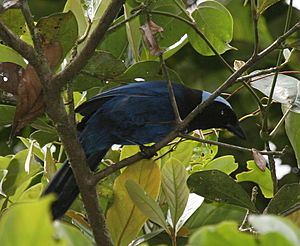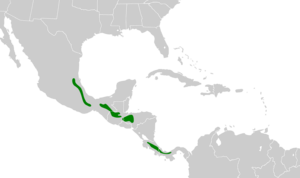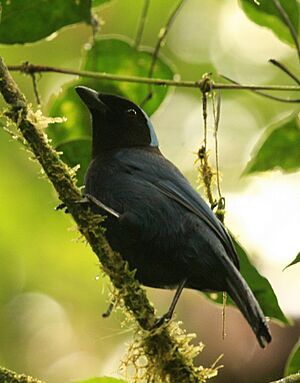Azure-hooded jay facts for kids
Quick facts for kids Azure-hooded jay |
|
|---|---|
 |
|
| San Gerardo, Alajuela, Costa Rica | |
| Conservation status | |
| Scientific classification | |
| Genus: |
Cyanolyca
|
| Species: |
cucullata
|
 |
|
The azure-hooded jay (Cyanolyca cucullata) is a beautiful bird found in Central America. It belongs to the Corvidae family, which includes jays, crows, and magpies. This bird lives in wet, subtropical or tropical mountain forests. It is about 28 to 30 centimeters (11 to 12 inches) long.
This jay is mostly dark blue. It has a black head and upper chest. The back of its head and neck are a bright sky blue with a white edge. Azure-hooded jays often travel in small groups. They are shy birds, so they are hard to spot in the wild. They eat many different things, like berries, seeds, and small dead animals. Females usually lay three to four eggs. The young birds leave the nest after about twenty days. This species is not in danger of extinction.
Contents
About the Azure-hooded Jay
What is a Cyanolyca cucullata?
The azure-hooded jay was first described in 1885 by an American bird expert named Robert Ridgway. Its scientific name, cucullata, means "hooded" in Latin. This name fits the bird well because of its distinct hood-like markings. The azure-hooded jay is closely related to the beautiful jay, which lives in Colombia and Ecuador. Scientists have studied their genes to confirm this close family link.
Where do Azure-hooded Jays Live?
There are four different types, or subspecies, of the azure-hooded jay. Each subspecies lives in a specific area:
- Cyanolyca cucullata mitrata: Found in eastern Mexico, from San Luis Potosí to north central Oaxaca.
- C. c. guatemalae: Lives in southern Mexico (Chiapas) and central Guatemala.
- C. c. hondurensis: Found in western Honduras.
- C. c. cucullata: This is the main type, found in Costa Rica and western Panama.
How to Identify an Azure-hooded Jay
Azure-hooded jays are about 28 to 30 centimeters (11 to 12 inches) long. They usually weigh around 100 grams (3.5 ounces). Their large size helps them fly a lot. Adult jays are dark blue with a black head and upper chest. The back of their head and neck are sky blue with a white border.
Their legs and bill are black, and their eyes are dark red. Male and female jays look very similar. Young jays are not as bright as adults. Their sky blue hood also lacks the white border.
What Does an Azure-hooded Jay Sound Like?
This bird has a loud, clear call. It sounds like eihnk-eihnk and is often repeated four or five times. They also make a nasal ehr-ehn or eh’enk sound twice. Sometimes, they give a low, rough cheh-r. Their alarm calls, used to warn others, sound like a "reek!" and are often high-pitched.
Where Azure-hooded Jays Live
You can find this bird in Costa Rica, Guatemala, Honduras, southeastern Mexico, and western Panama. They prefer to live in humid evergreen forests. Sometimes, these forests have pine trees mixed in. Jays are usually found at the edges of these forests. They stay in the middle and upper parts of the trees. They also like areas where cloud forests are continuous and not broken up.
Azure-hooded Jay Behavior
These jays often join groups of other bird species. They might fly with unicolored jays or emerald toucanets. They also travel in groups of two to ten other azure-hooded jays. They are very shy and secretive birds. They rarely come out into the open. Because of this, it is hard to watch them in the wild. This means scientists don't know a lot about their daily lives.
Mates often preen each other. This is when one bird bends over and lets the other gently tug on its throat feathers. The feathers on their head often move quickly. Scientists think this movement might show how healthy a mate is.
Like other jays, this species is probably very smart. Other jays are known to use ants to clean their feathers. They also store seeds and nuts for later. They can even use their toes to hold food. However, because the azure-hooded jay is so secretive, these behaviors have not been seen in them yet.
Their bright blue feathers make them easy for predators to spot. When a jay feels threatened, it makes a loud warning call.
What Do Azure-hooded Jays Eat?
The azure-hooded jay is an omnivore. This means it eats both plants and animals. They eat berries, seeds, and small, dead animals. These jays have even been known to steal bait from traps set for small mammals. They usually look for food high up in the forest canopy.
How Do Azure-hooded Jays Reproduce?
The jay's nest is usually built high up in a tree. It is about 5 to 7 meters (16 to 23 feet) above the ground. They build their nests close to a tree trunk. The base of one studied nest was made of small twigs. The inside of the nest was about 11 centimeters (4.3 inches) wide. The whole nest could be 19 to 33 centimeters (7.4 to 13 inches) wide, depending on the outer twigs.
The nest is about 5 centimeters (2 inches) deep. The inside is woven with thin fibers and twigs. They do not use feathers or other soft materials to line the nest. Sometimes, these jays will even use old nests built by other birds. Females usually lay three to four eggs. The young birds are typically in the nest between April and June. They take at least 20 days to fledge, which means they grow feathers and learn to fly. Both parents take care of the young. They feed them different insects, like katydids. After the young jays fledge, they stay close to their parents.
Protecting the Azure-hooded Jay
The azure-hooded jay is listed as a species of Least Concern. This means it is not currently threatened with extinction. This is because it lives across a large area, about 110,000 square kilometers (42,500 square miles). Even though its exact population isn't known, it is believed to be over 10,000 birds. Also, its population has not dropped by 30% in the last ten years. However, the azure-hooded jay is not common in all parts of its home range. Deforestation, which is when forests are cut down, might also affect these birds.
Jays and Humans
While not seen in this specific species, some closely related jays are known to eat crops planted by humans. This includes fruits from orchards, sugarcane, pineapples, and potatoes. The azure-hooded jay has appeared on a stamp in Mexico in 1996.




